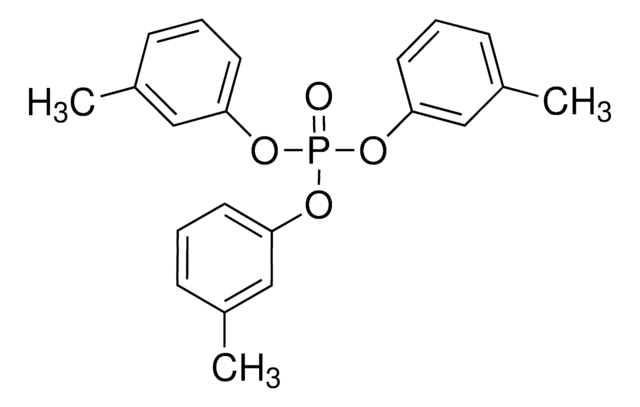241288
Triphenyl phosphate
≥99%
Synonym(s):
Triphenoxyphosphine oxide
About This Item
Recommended Products
vapor pressure
1.3 mmHg ( 200 °C)
assay
≥99%
bp
244 °C/10 mmHg (lit.)
mp
48-50 °C (lit.)
solubility
acetone: soluble(lit.)
alcohol: moderately soluble(lit.)
benzene: soluble(lit.)
chloroform: soluble(lit.)
diethyl ether: soluble(lit.)
water: insoluble(lit.)
SMILES string
O=P(Oc1ccccc1)(Oc2ccccc2)Oc3ccccc3
InChI
1S/C18H15O4P/c19-23(20-16-10-4-1-5-11-16,21-17-12-6-2-7-13-17)22-18-14-8-3-9-15-18/h1-15H
InChI key
XZZNDPSIHUTMOC-UHFFFAOYSA-N
Looking for similar products? Visit Product Comparison Guide
General description
application
signalword
Warning
hcodes
pcodes
Hazard Classifications
Aquatic Acute 1 - Aquatic Chronic 1
Storage Class
11 - Combustible Solids
wgk_germany
WGK 2
flash_point_f
428.0 °F - closed cup
flash_point_c
220 °C - closed cup
ppe
Eyeshields, Gloves
Certificates of Analysis (COA)
Search for Certificates of Analysis (COA) by entering the products Lot/Batch Number. Lot and Batch Numbers can be found on a product’s label following the words ‘Lot’ or ‘Batch’.
Already Own This Product?
Find documentation for the products that you have recently purchased in the Document Library.
Customers Also Viewed
Our team of scientists has experience in all areas of research including Life Science, Material Science, Chemical Synthesis, Chromatography, Analytical and many others.
Contact Technical Service











